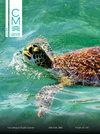Invasive mangroves produce unsuitable habitat for endemic goby and burrowing shrimp pairs in Kāneʻohe Bay, O‘ahu, Hawai‘i
IF 0.7
4区 生物学
Q4 MARINE & FRESHWATER BIOLOGY
引用次数: 0
Abstract
Hawai‘ian ecosystems evolved in relative isolation and support an abundance of native and endemic species. As such, they are particularly vulnerable to introduced species that alter habitat and interfere with species interactions. Although mangroves are valued globally for shoreline protection and other services, their invasion of the Hawai‘ian islands may have negative effects on the abundance and functions of native species. On an island in Kāne‘ohe Bay, O‘ahu, we explored the relationship between invasion of the red mangrove, Rhizophora mangle, and abundance of the native burrowing shrimp Alpheus rapax, which shares its burrows with the endemic goby Psilogobius mainlandi in a mutualism that reduces predation on both. We hypothesized that the abundance of shrimp/goby burrows is reduced beneath mangroves due to increased cover associated with mangrove prop roots, which trap leaves and debris and may harbor the invasive red alga Gracilaria salicornia. At 3 mangrove-invaded sites, we conducted a survey of burrow density and benthic debris and found ~4–5× lower burrow density and 4× greater cover of debris under the mangrove edge compared to sandflats that were 1.5 and 5.0 m away. Burrow density was negatively correlated with total cover of benthic debris and with subgroups of that cover composed of G. salicornia or leaves. We tested the effect of debris removal over 2 weeks, which resulted in 3–8× more burrows. Thus, we provide evidence that invasive red mangroves, through trapping leaves and promoting presence of invasive G. salicornia among their prop roots, have strong negative effects on shrimp/goby burrow density. Although our study was limited in spatial scope, we propose that current efforts to remove mangroves in Hawai‘i, for both cultural and ecological reasons, will mitigate negative effects on endemic goby and native shrimp habitat.入侵的红树林为夏威夷奥胡岛Kāne霍奥赫湾特有的虾虎鱼和穴居虾对提供了不合适的栖息地
夏威夷的生态系统在相对孤立的环境中进化,支持着大量的本地和特有物种。因此,它们特别容易受到改变栖息地和干扰物种相互作用的引入物种的影响。尽管红树林在全球范围内因海岸线保护和其他服务而受到重视,但它们对夏威夷岛屿的入侵可能会对本地物种的丰富度和功能产生负面影响。在O 'ahu岛Kāne 'ohe湾的一个岛屿上,我们探索了红红树林,Rhizophora mangle的入侵与本地穴居虾Alpheus rapax的丰度之间的关系,这种虾与当地的虾虎鱼Psilogobius mainlandi共享洞穴,相互作用减少了对两者的捕食。我们假设,红树林下虾虾/虾虎鱼洞穴的丰度减少是由于红树林支撑根的覆盖增加,红树林支撑根会捕获树叶和碎片,并可能庇护入侵的红藻海角紫菜。在3个红树林入侵点,我们进行了洞穴密度和底栖生物碎屑的调查,发现红树林边缘的洞穴密度比1.5 m和5.0 m外的沙地低4 - 5倍,碎屑覆盖率高4倍。洞穴密度与底栖生物碎屑的总覆盖层呈负相关,与底栖生物碎屑的亚群组成呈负相关。我们在两周内测试了清除碎片的效果,结果是挖出的洞穴增加了3 - 8倍。因此,我们提供的证据表明,入侵红红树通过捕获叶片和促进入侵海角藻在其支撑根中的存在,对虾虎鱼的洞穴密度产生了强烈的负面影响。虽然我们的研究在空间范围上是有限的,但我们提出,目前在夏威夷清除红树林的努力,出于文化和生态的原因,将减轻对当地虾虎鱼和本地虾类栖息地的负面影响。
本文章由计算机程序翻译,如有差异,请以英文原文为准。
求助全文
约1分钟内获得全文
求助全文
来源期刊

Ciencias Marinas
生物-海洋与淡水生物学
CiteScore
1.10
自引率
0.00%
发文量
9
审稿时长
>12 weeks
期刊介绍:
A bilingual open-access publication, Ciencias Marinas (CM) is an international peer-reviewed journal that contains original research findings in all areas of marine science. It is published quarterly by the Autonomous University of Baja California, Mexico, and all its contents are publicly available on our journal website. Though a limited number of copies are still printed, the journal is mainly distributed in its electronic format.
CM was conceived in 1973 as part of an academic project aimed to entice local researchers to publicly disclose their findings by adopting the culture of peer-review publishing. This academic project evolved into an international journal after accepting papers from researchers in the United States and, eventually, other parts of the world. Because of the diversity in authorship, CM issues were initially published in either Spanish or English, and occasionally in both languages. It was not until 1984 when CM included both language versions of all its contents, and it then became the fully bilingual journal it still is today. At CM we believe our inclusive format allows us not only to address a wider range of submissions from international authors but also to make published findings available to a wider international audience.
So whether you are looking for information on the redfish in Icelandic waters or the physical and biological properties of the Gulf of California, feel free to peruse CM contents. You may find them to provide source material for your research.
 求助内容:
求助内容: 应助结果提醒方式:
应助结果提醒方式:


